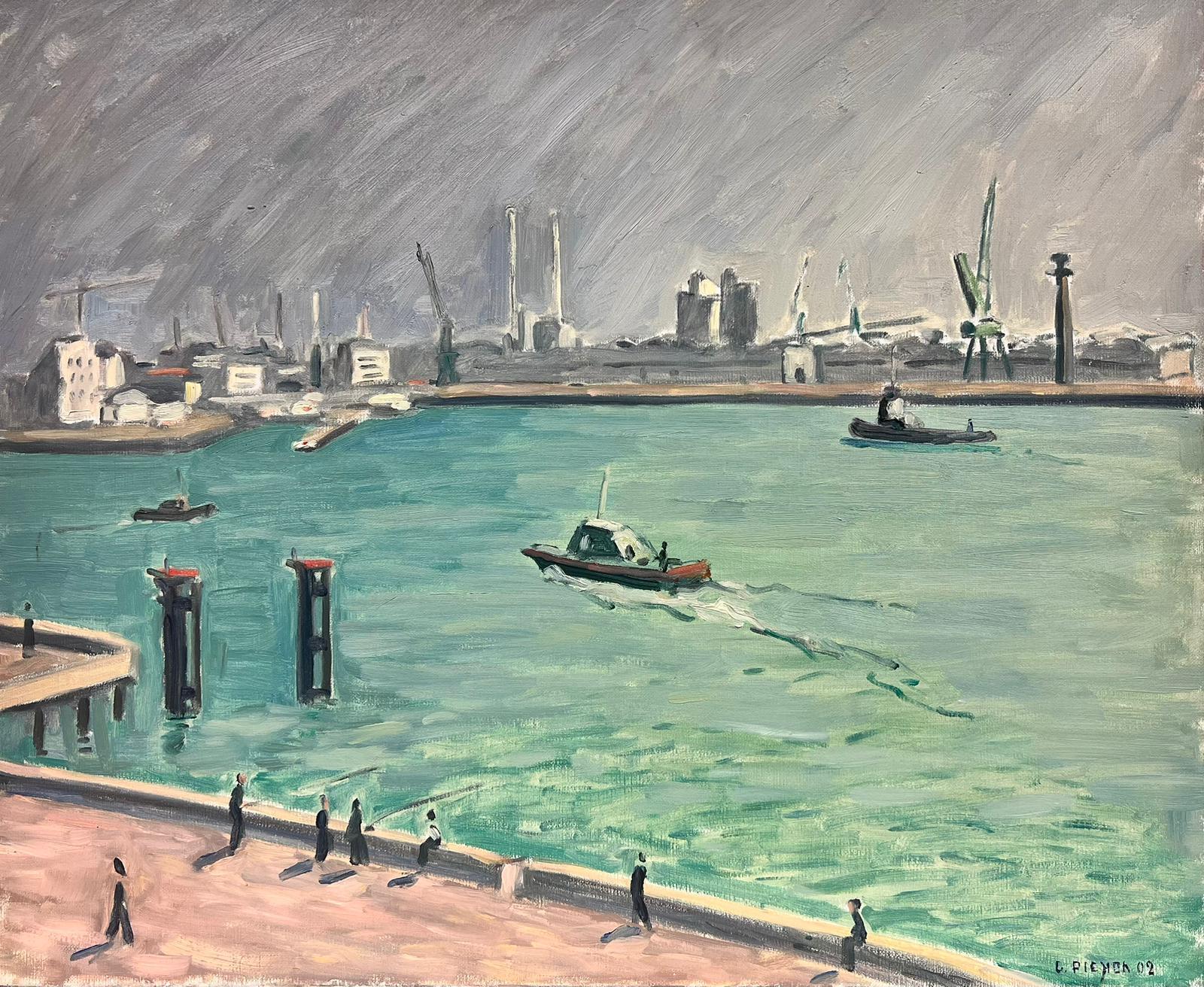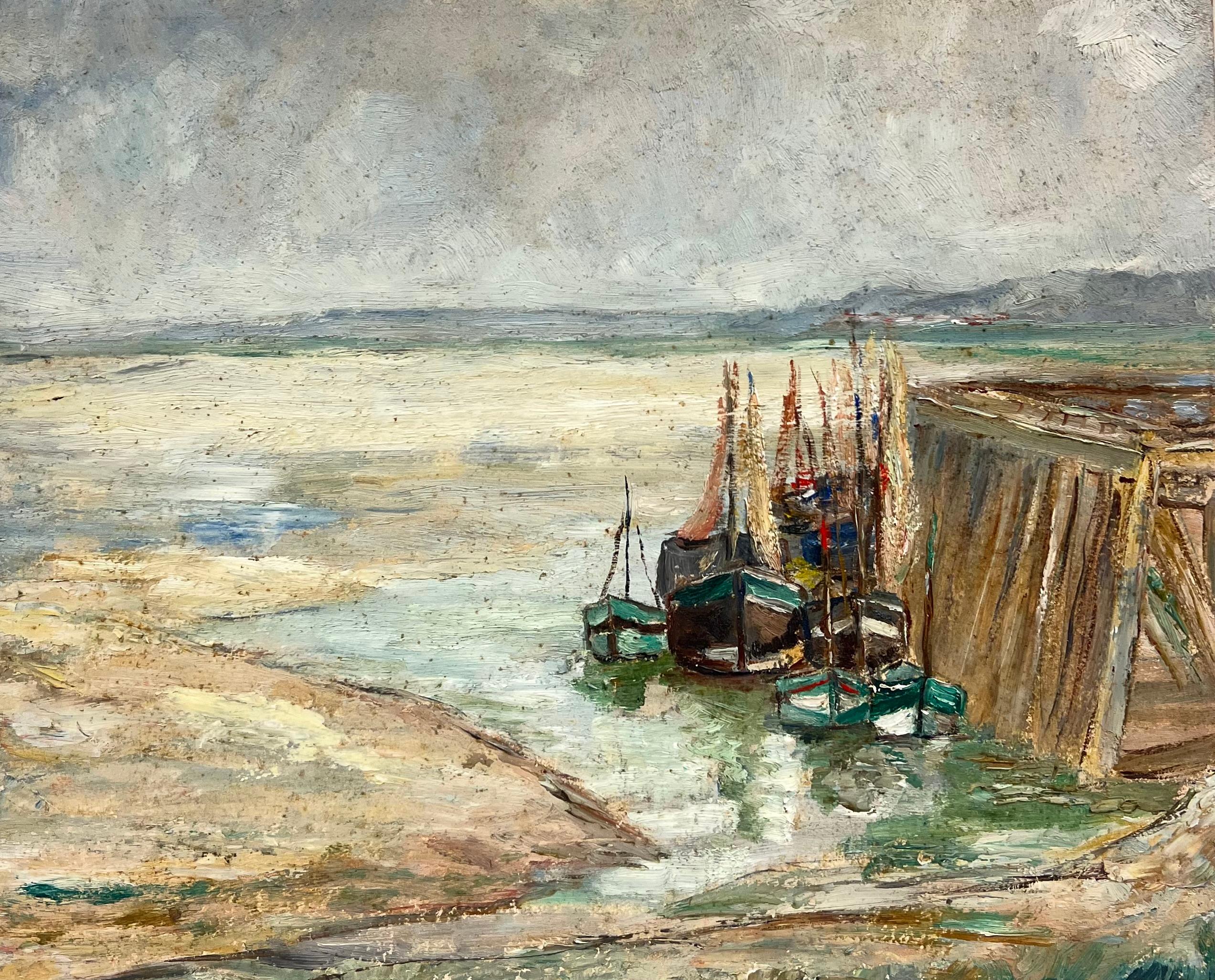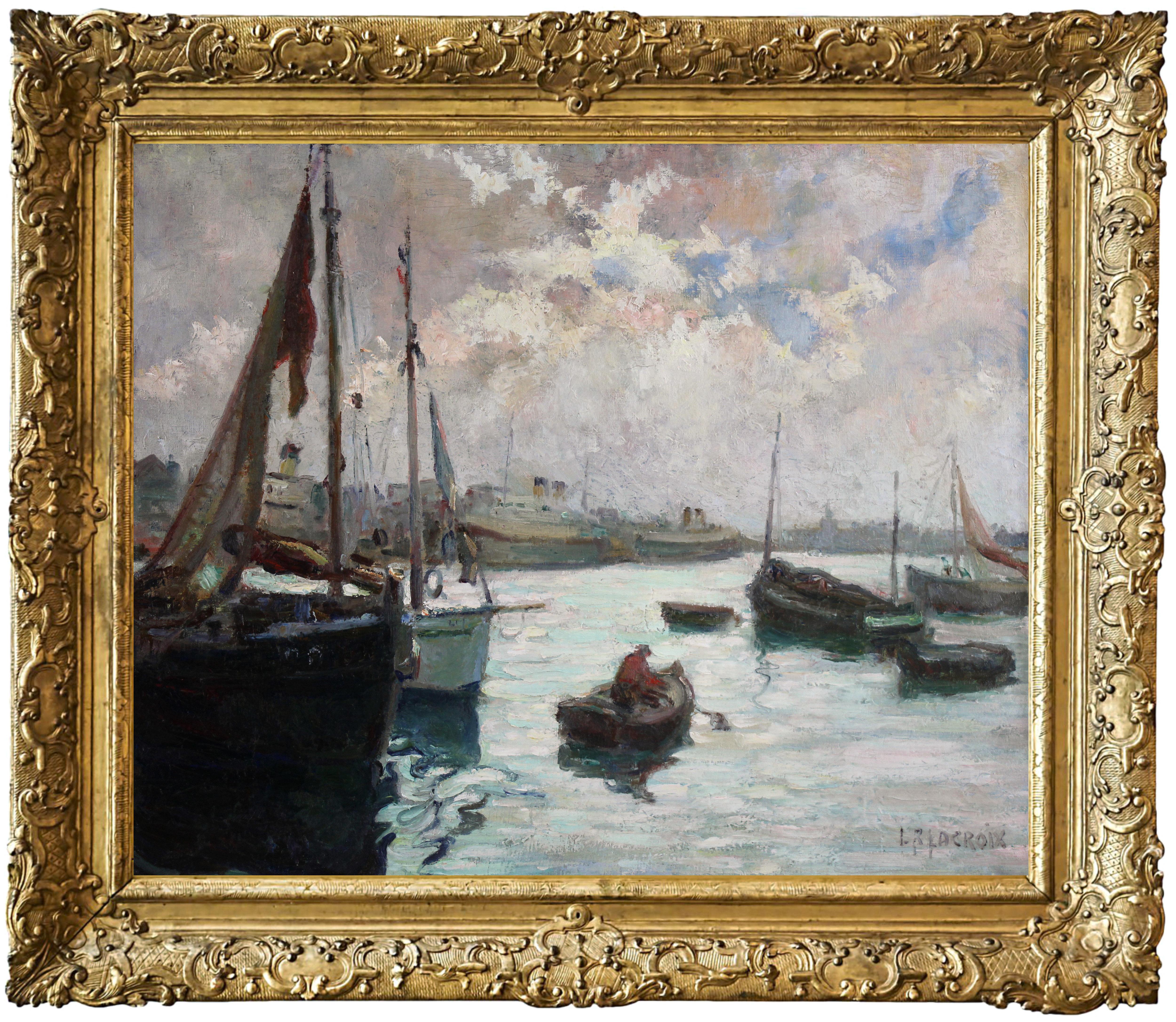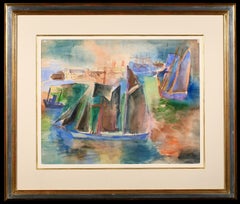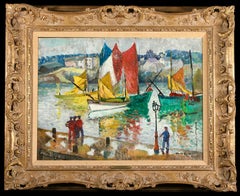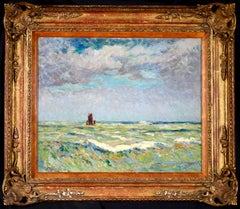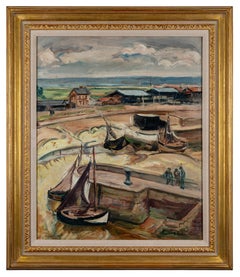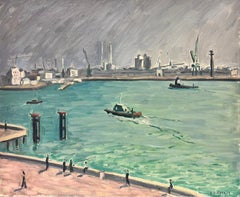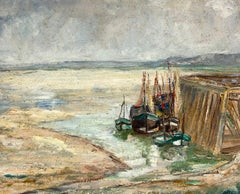Articoli simili a Porto di Le Havre e Sainte-Adrese - Olio post impressionista sul paesaggio marino - Othon Friesz
Vuoi altre immagini o video?
Richiedi altre immagini o video al venditore
1 di 17
Achille-Émile Othon FrieszPorto di Le Havre e Sainte-Adrese - Olio post impressionista sul paesaggio marino - Othon Friesz1921
1921
23.374,91 €
Informazioni sull’articolo
Signed and dated oil on canvas seascape by French post impressionist painter Achille-Emile Othon Friesz. The piece depicts a view of Le Havre, a port city in Normandy, France, located at the mouth of the Seine River on a stormy day. Sainte-Adresse is a coastal suburb located 2 miles (3.2 km) northwest of Le Havre city center. There are boats out at sea under an overcast sky and works on the beach to the foreground.
Signature:
Signed and dated 1921 lower right
Dimensions:
Framed: 31"x38"
Unframed: 26"x33"
Provenance:
Private French collection
The authenticity of this work has been confirmed by Mme. Odile Aittouarès
Achille-Émile Othon Friesz was the son of a family of sailors from Le Havre. From 1885 he often spent time in Marseilles visiting his maternal uncles. As a child he dreamed of going to sea, but from the age of 12 he developed a passion for art, and after secondary school he attended the École des Beaux-Arts in Le Havre. There, from 1896 to 1898, he studied under Charles-Marie Lhullier who had been a friend of Jongkind and whom, like Dufy and Braque, he remembered fondly throughout his life. Lhullier introduced his students to the work of Chardin, Corot, Géricault and Delacroix.
After receiving a bursary from the local authorities in 1898, he went to Paris and, while his friends Matisse, Rouault and Marquet studied under Gustave Moreau, enrolled at the École des Beaux-Arts at the studio of Léon Bonnat, where he was joined by Dufy. However, he scarcely attended the studio, preferring to go to the Louvre and make copies of the works of Clouet, Veronese, Rubens, Claude Lorraine and Delacroix. He did his military service in Paris in 1902 but continued with his art. Around this time he met Camille Pissarro and sought his advice.
As a young man he began to make frequent trips away, not necessarily travelling very far, but looking for subjects for his work, usually landscapes. Among the places he visited were the Creuse region around 1903, Antwerp in 1905, returning there with Braque in 1906, and La Ciotat, Cassis and L'Estaque in 1906-1907, again in the company of Braque. In Paris he frequently moved lodgings until 1914. He moved in with Henri Matisse at the Couvent des Oiseaux from 1905-1910, that is to say at the period when Fauvism was at its height. In 1908 he returned to his native Normandy to reimmerse himself in his early environment; he would return to the region throughout his life. He made a trip to Munich with Dufy in 1909, and visited Portugal in 1911-1912 and Belgium in 1912. In 1914 he was called up and assigned to technical services, not being demobilised until March 1919, although he did manage to maintain a certain independence. From 1914 until his death he lived in Paris at 73 Rue Notre-Dame-des-Champs, where he occupied Bouguereau's old studio. He made frequent trips to Cap-Brun near Toulon where, in 1923, he acquired a property called Les Jarres, as well as making numerous visits to Normandy and Le Havre.
In 1925 he received the highest commendation at the Carnegie Prize in Pittsburgh for Portrait of the Decorative Artist Paul Paquereau. Also in 1925, at the same time as Matisse, he was made a Chevalier of the Légion d'Honneur, rising to in Officier in 1933 and Commandeur in 1937. He was also made Commander of the Swedish order of Vasa in 1934. Throughout his life, Friesz was a teacher: from 1913 at the Académie Moderne; from 1929 at the Académie Scandinave; and from 1941 until his death at the Académie de la Grande-Chaumière.
Alongside his activity as a painter, he illustrated several works of literature, including: in 1920 Le Pacte de l'Écolier Juan by Jules Tellier; in 1924 Échelles de Soie by Jean Pédron; in 1926 Le Jardin sur l'Oronte by Maurice Barrès; in 1926 En Suivant la Seine by Gustave Coquiot; in 1929 Rouen by André Maurois; in 1931 The Song of Songs; in 1934 Poésies by Pierre de Ronsard; in 1945 Le Bouquet de la Mariée by Gabriel-Joseph Gros; in 1947 Paul et Virginie by Bernardin de St-Pierre; in 1949 Le Livre de Job by Pierre Poussard; in 1949 Petronius's Satyricon, and in 1949 a collection of 12 unpublished lithographs for Le Désert de l'Amour by François Mauriac. He also designed several pieces of decorative art: from 1906 to 1909 ceramics executed by Metthey among others; a façade for a private house in Le Havre; a china service for two for the Le Havre writer J.-G. Aubry; vases, dishes and plates; in 1912 four sets for La Lumière by Georges Duhamel, performed at the Odéon; in 1916 a screen for the Le Havre collector Léon Pédron; in 1918 panels for Pédron's dining room; in 1920 a mural entitled Children Dancing (Enfants Dansant); in 1920 Les Volières for the apartment of Vicomte Amédée de Flers; in 1935 Peace (La Paix), a Gobelins tapestry presented by France to the Palais des Nations in Geneva; in 1937 La Seine in collaboration with Dufy for the Palais de Chaillot, with each artist taking half of the river's course - From the Source to Paris by Friesz and From Paris to the Estuary by Dufy.
The Fauves were producing Fauve paintings before they knew it: it was not until the critic Louis Vauxcelles saw their work at the Salon des Indépendants in 1905 and mockingly used the word Fauve to describe it that the term was born. It is known that Vlaminck and Derain worked together and that the École de Chatou was composed of just these two artists. Friesz was living with Matisse and after his first trip to Antwerp in 1905, he returned in 1906 with Braque. In 1906-1907 Friesz and Braque went to La Ciotat to paint and there they met up with Matisse. The paintings Friesz produced in Antwerp are Fauve inasmuch as they are painted in pure colours and are more or less free of the divisionism of the Impressionists, although the draughtsmanship is fairly standard; these works include The Port, The Escaut, The Canals, The Dock with Sailing Ships and The Red Slipway. Those of Braque the following year, in particular Terrace on the Escaut, show great similarities with those Friesz painted of the same subject. Friesz was already avoiding the hardness of pure flat tints by graduating them in thin glazes, allowing the whiteness of the canvas to penetrate the transparency, a technique that came to characterise his entire Fauve period.
At La Ciotat Friesz and Braque adopted completely different Fauve styles, with Braque composing his paintings on horizontal and vertical orthogonals painted in small, regular, spaced-out touches, whereas Friesz developed his own personal rhythmical style of wide arabesques of colour in works such as The Bec-de-l'Aigle, Women Bathing and L'Estaque. Many of Friesz's Fauve works were produced in the south of France, and his Portrait of Fernand Fleuret also dates from this period.
When he returned to Normandy in 1908 the period that he described as his 'return to form' began; with compromise paintings such as Entrance to the Port of Honfleur, Côte de Grâce Landscape, The 'Bains Marie-Christine' in Le Havre and the great compositions characteristic of this period - Autumn Labours, Spring, Fisherman on a Rock and Women Bathing. His draughtsmanship retains something of the rhythm of the Fauve period, his figures following the lines of the landscape and the colour remaining clear and resonant. In 1909 he painted the Cirque Médrano series: The Trapeze Artist, The Clown and The Horsewoman. In the south of France he also painted the Olive Trees series. He made a trip to Munich with Raoul Dufy resulting in Winter in Munich. This was also the year of his first trip to Italy. Boat in a Rocky Inlet of 1910 marks one of the pivotal points between a totally rhythmic drawing style of sensual curves typical of his Fauve period and a reduced palette of muted ochres, browns and blues. From 1910 onwards, the final traces of Fauvism become less and less apparent in his work. His use of colour follows the same course, towards the transcription of reality, with broken tones, ochres and browns.
After his demobilisation, as well as in his studio in Paris, Friesz spent time in his house in Toulon, returned to Normandy and Le Havre and continued to make frequent, often local, forays in search of new subjects: in 1919 to Jura, producing the series Forests, Pine Trees, Road in the Snow and Invitation to Skate; in 1920 to Italy producing Piedmont Village, Florence Grape Pickers; in 1920 to Le Havre, producing The Étretat Cliffs, People Bathing at Étretat; in 1923 to his house in Toulon, producing View of Coudon, Women Bathing, Grape Harvesting, Jars; in 1924 he painted the Large Nude (which he exhibited at the Salon d'Automne the same year) and landscapes of Toulon; in 1928 he made a trip to Algiers, producing The Algiers Kasbah and its Phantoms; in 1931 to Annecy, producing Women Bathers by a Lake; in 1934-1935 to Dinan and St-Malo producing The Great Dinan Viaduct, The Dock with the Terre-Neuvas, After Bathing; in 1936 to Honfleur; in 1941-1944, remaining in Paris because of the war, he painted mainly still-lifes, including Studio Corner, Earthenware. In 1946 he returned to Honfleur; and in 1947 to La Rochelle producing The Port Tower, Tuna Boats, The Red Sail.
Numerically Friesz's work is dominated by landscapes but it should be remembered that throughout his career he tackled more ambitious compositions and appeared to do so with great ease. These include Boat in a Rocky Inlet of 1910 with its frolicking women bathers, Allegory of War of 1915 executed in 24 hours, Invitation to Skate of 1919, numerous paintings of Women Bathing over several periods and much later Women beside a Pond of 1944, which clearly demonstrates his attachment to Cézanne.
He exhibited at the Salon des Artistes Français from 1901 to 1903 and then at the Salon des Artistes Indépendants. From 1906 he exhibited annually at the Salon d'Automne, of which he later became a committee and jury member. In 1923 he took part in the founding of the Salon des Tuileries and became head of two of the Salon's sections. His work has been exhibited at countless group exhibitions all over the world. Among the most recent thematic exhibitions is Fauvism in Black and White. From Gauguin to Vlaminck, Fauvist Engraving and its Setting (Le Fauvisme en Noir et Blanc. De Gauguin à Vlaminck, l'Estampe des Fauves et son Environnement) at the Musée d'Art Moderne in Villeneuve d'Ascq in 2001.
He also showed his work in numerous solo exhibitions in Paris: his first in 1904 at the Galerie des Collectionneurs and another the same year at the Société des Peintres du Paris Moderne; in 1905 at the Galerie Berthe Weill; under contract at the Galerie Druet from 1907; with the Galerie Katia Granoff from 1924; and from December 1939 until his death with the Galerie Pétridès. He exhibited in Paris in other galleries than those with which he was contracted, and outside Paris he held solo exhibitions in 1913 at the Cassirer gallery, Berlin; in 1921, 1928, 1936 and 1958 in London; in 1921 and 1950 in Le Havre; in 1925 and 1929 in Brussels; in 1929 and 1938 in New York; in 1930 in Chicago; in 1938 in Zurich; and in 1948 in Lucerne and Geneva. His posthumous exhibitions and retrospectives include: a tribute in 1949 at the Salon d'Automne in Paris; a retrospective in 1950 at the Galerie Charpentier in Paris; an exhibition in 1950 in Geneva and again in 1953 at the Musée d'Art et d'Histoire; in 1950 at the Musée de Toulon; in 1950 in Marseilles; in 1951 at the Algiers museum; in 1951 at the Musée d'Honfleur; in 1956 at the Musée de Dieppe; in 1979 at the Musée de la Rochelle and the Musée de La Roche-sur-Yon; in 1989 the E. Othon Friesz, Rétrospective at the Galerie Katia Granoff, Paris; 1995, Émile Othon Friesz. Périodes Fauve et Cézannienne (1906-1920) at the Galerie Larock-Granoff in Paris.
Museum and Gallery Holdings:
Albi: drawings
Arles: drawings
Baltimore: Women Bathing (1926)
Copenhagen: Madame and Jacqueline F.
Copenhagen (Statens Mus. for Kunst): Motherhood (1914)
Geneva (MAH): St-Cirq-Lapopie (1946)
Geneva (Petit Palais): Corvette Entering Port (1906); Women Bathing (1907)
Grenoble: Allegory of War (1915); Grape Harvesting (1923); Le Coudon (1923)
Le Havre: Landscape
Leeds (City AG): Honfleur (1937, oil on canvas)
Lille (Mus. de Picardie)
Moscow: Rouen Cathedral (1908)
New York (MoMA)
Oslo: Autumn Labours (1908); The Red Street (1905)
Paris (MNAM-CCI): La Ciotat (1906); L'Estaque (1906); Portrait of Fernand Fleuret (1906); Portrait of Madame Andrée Othon Friesz (1923); Landscape of Méounes, Var (1925); Port of Dieppe (1930)
Paris (Mus. de l'Armée): The French Enter Strasbourg (1918); Maréchal Joffre on Horseback (drawings)
Paris (Mus. de l'Aviation): Air Force Camps during the 1914-1918 War (studies)
Poitiers: drawings and lithographs
St-Malo: Women Bathers by the Sea; The Old Town of St-Malo before the Destruction Caused by the 1939-1945 War (drawings)
Stockholm: Port of Honfleur
Toulon: The Artist's House at Toulon (1919); Nude (drawings)
Troyes (MAM, Pierre and Denise Lévy donation): L'Estaque (1906)
Zurich: Cassis Landscape (1909)
- Creatore:Achille-Émile Othon Friesz (1879 - 1949, Francese)
- Anno di creazione:1921
- Dimensioni:Altezza: 78,74 cm (31 in)Larghezza: 96,52 cm (38 in)
- Tecnica:
- Movimento e stile:
- Periodo:
- Condizioni:Very good condition.
- Località della galleria:Marlow, GB
- Numero di riferimento:Venditore: LFA05041stDibs: LU415316484502
Achille-Émile Othon Friesz
Othon Friesz era originario di Le Havre, in Francia, dal 1879 al 1949. Era un artista francese del movimento fauvista. Era un buon amico di Raoul Dufy e conobbe Matisse, Marquet e Rouault con cui espose nel 1907. Negli ultimi anni dipinse in uno stile molto diverso da quello degli anni precedenti. An He rispettava lo stile di Cezanne che prevedeva una composizione logica, una tonalità semplice, la solidità dei volumi e la netta separazione dei piani e un sapore barocco nel suo stile. È noto per la pittura fauve e tradizionale, i paesaggi, le nature morte e lo stile figurativo. An He ammirava le opere dei modernisti. Le sue opere si trovano nei principali musei del mondo.
Informazioni sul venditore
5,0
Venditore Oro
Venditori Premium con valutazione 4,3+ e tempi di risposta entro 24 ore
Fondazione nel 2001
Venditore 1stDibs dal 2016
706 vendite su 1stDibs
Tempo di risposta standard: <1 ora
- SpedizioneRecupero del preventivo…Spedizione da: Marlow, Regno Unito
- Politica di reso
Alcune parti di questa pagina sono state tradotte automaticamente. 1stDibs non può garantire che le traduzioni siano corrette. L’inglese è la lingua predefinita del sito.
Garanzia di autenticità
Nell’improbabile caso in cui si verifichi un problema con l’autenticità di un articolo, contattaci entro un anno per ottenere un rimborso completo. DettagliGaranzia di rimborso
Se il tuo articolo non corrisponde alla descrizione, è danneggiato durante il trasporto o non arriva, contattaci entro 7 giorni per un rimborso completo. DettagliAnnullamento entro 24 ore
Hai un periodo di tolleranza di 24 ore per annullare il tuo acquisto, senza necessità di fornire spiegazioni.Venditori professionali selezionati
I nostri venditori di livello internazionale devono aderire a rigorosi standard di servizio e qualità, garantendo l’integrità delle inserzioni.Garanzia miglior prezzo
Se scopri che un venditore ha pubblicato altrove lo stesso articolo a un prezzo più basso, applicheremo lo stesso prezzo.Consegna globale affidabile
La nostra rete di vettori leader del settore offre opzioni di spedizione specializzate in tutto il mondo, inclusa la consegna personalizzata.Altro da questo venditore
Mostra tuttoLe Port due Havre - Paesaggio acquerellato post impressionista di Jean Dufy
Di Jean Dufy
Acquerello post impressionista su carta firmato e datato del pittore francese Jean Dufy. Questo pezzo colorato raffigura delle barche a vela nel porto di Le Havre, in Francia, un por...
Categoria
Anni 1920, Postimpressionismo, Dipinti (paesaggio)
Materiali
Carta, Acquarello
Porto di St. Ives - Paesaggio marino con figure impressioniste, olio di Richard Hayley Lever
Di Richard Hayley Lever
Figure firmate in un paesaggio olio su tavola del pittore impressionista australiano-americano Richard Hayley Lever. L'opera raffigura barche a vela dai colori vivaci nel porto di St...
Categoria
Inizio Novecento, Impressionismo, Dipinti figurativi
Materiali
Olio, Tela
Tempo di tempesta - Honfleur - Olio post impressionista, paesaggio marino di H. H. Saint-Delis
Un meraviglioso olio su tela del 1908 circa del pittore francese post impressionista Henri Liénard de Saint-Délis che raffigura una barca attraccata al porto di Honfleur, nel nord de...
Categoria
Inizio Novecento, Postimpressionismo, Dipinti (paesaggio)
Materiali
Olio, Tela
Grosse Mer - Etretat - Paesaggio marino impressionista Olio di Maxime Maufra
Di Maxime Maufra
Dipinto impressionista a olio su tela con paesaggio marino del 1895 circa dell'artista francese Maxime Maufra. Questa splendida opera raffigura una barca a vela in un vasto oceano. L...
Categoria
Anni 1890, Impressionismo, Dipinti (paesaggio)
Materiali
Tela, Olio
Parigi - Les Inondations - Paesaggio impressionista dipinto a olio da Maxime Maufra
Di Maxime Maufra
Paesaggio impressionista su tela firmato dal pittore francese Maxime Maufra. L'opera raffigura persone che remano in barca per le strade allagate di Parigi.
Firma:
Firmato in basso...
Categoria
Anni 1910, Impressionismo, Dipinti (paesaggio)
Materiali
Olio, Tela
Les Vagues a Agay - Paesaggio marino fauvista dipinto a olio da Louis Valtat
Di Louis Valtat
Paesaggio marino fauvista su tavola firmato nel 1900 circa dal pittore francese Louis Valtat. Questo splendido pezzo raffigura una vista di grandi onde che si infrangono contro grand...
Categoria
Inizio Novecento, Fauvismo, Dipinti (paesaggio)
Materiali
Olio, Pannello
Ti potrebbe interessare anche
Vieux Bassin de Honfleur
Di Achille-Émile Othon Friesz
Achille-Emile Othon Friesz
Francese, 1879-1949
Vieux Bassin de Honfleur
Olio su tela
23 ½ per 28 ¾ in, con cornice 31 ⅜ per 36 ½ in
Firmato in basso a destra
Achille-Emile Othon Fr...
Categoria
Inizio XX secolo, Fauvismo, Dipinti (paesaggio)
Materiali
Olio
Dipinto a olio firmato da un impressionista francese Barche in un porto industriale affollato
Il porto
di Guy Pichon (francese 1933-2007)
olio su tela, senza cornice
firmato
tela: 21 x 26 pollici
provenienza: collezione privata, Francia
Il dipinto è in condizioni molto buo...
Categoria
XXI secolo e contemporaneo, Impressionismo, Dipinti (paesaggio)
Materiali
Olio
Vue Du Vieux Port De Dieppe (Francia), 1920-30 - pittura a olio, 98x116 cm., incorniciato
Di Leopold Levy
Olio su tela, firmato in basso a sinistra
Henri-Léopold Lévy (23 settembre 1840, Nancy - 29 dicembre 1904, Parigi) è stato un pittore francese di origini ebraiche, noto soprattutto p...
Categoria
Anni 1920, Postimpressionismo, Dipinti figurativi
Materiali
Olio
Porto con bassa marea e barche vicino al molo Impressionista francese del 1930
Barche con la bassa marea
Simone Forge 1930 Impressionista francese
olio su tavola senza cornice
tavola: 13 x 16 pollici
Provenienza: collezione privata
Condit: ottime condizioni
...
Categoria
Inizio XIX secolo, Impressionismo, Dipinti (paesaggio)
Materiali
Olio
Pittura a olio su tela francese "Vibrante scena del porto di Dieppe".
Pittura a olio su tela francese "Vibrante scena del porto di Dieppe".
Ulteriori informazioni sull'opera:
Titolo: La vivace scena del porto di Dieppe
Medium: olio su tela
Firma: fir...
Categoria
Anni 1920, Impressionismo, Dipinti (paesaggio)
Materiali
Tela, Olio
Promenade Le Havre Harbor French 1950s Framed Oil Painting Mid 20th Century
Di Fred Pailhès
Alfred Henri Pailhès.
Francese ( nato nel 1902 - morto nel 1991 ).
Appuntamento degli Havrais per la loro passeggiata dominicale.
Olio su pannello.
Firmato in basso a sinistra.
Dimen...
Categoria
Metà XX secolo, Postimpressionismo, Dipinti (paesaggio)
Materiali
Olio, Tavola

